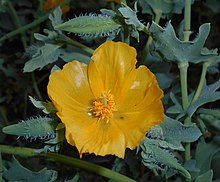
Eschscholzia californica, the California poppy, golden poppy, California sunlight or cup of gold, is a species of flowering plant in the family Papaveraceae, native to the United States and Mexico. It is cultivated as an ornamental plant flowering in summer, with showy cup-shaped flowers in brilliant shades of red, orange and yellow. It is also used as food or a garnish. It became the official state flower of California in 1903.

A poppy is a flowering plant in the subfamily Papaveroideae of the family Papaveraceae. Poppies are herbaceous plants, often grown for their colourful flowers. One species of poppy, Papaver somniferum, is the source of the narcotic drug mixture opium, which contains powerful medicinal alkaloids such as morphine and has been used since ancient times as an analgesic and narcotic medicinal and recreational drug. It also produces edible seeds. Following the trench warfare in the poppy fields of Flanders, Belgium, during World War I, poppies have become a symbol of remembrance of soldiers who have died during wartime, especially in the UK, Canada, Australia, New Zealand and other Commonwealth realms.

The Papaveraceae, informally known as the poppy family, are an economically important family of about 42 genera and approximately 775 known species of flowering plants in the order Ranunculales. The family is cosmopolitan, occurring in temperate and subtropical climates like Eastern Asia as well as California in North America. It is almost unknown in the tropics. Most are herbaceous plants, but a few are shrubs and small trees. The family currently includes two groups that have been considered to be separate families: Fumariaceae and Pteridophyllaceae. Papaver is the classical name for poppy in Latin.

Chelidonium majus, the greater celandine, is a perennial herbaceous flowering plant in the poppy family Papaveraceae. One of two species in the genus Chelidonium, it is native to Europe and western Asia and introduced widely in North America.

Glaucium is a genus of about 25 species of annual, biennial or perennial herbaceous flowering plants in the family Papaveraceae, native to Europe, north Africa, and southwest and central Asia. The species commonly occur in saline habitats, including coasts and salt pans.

Papaver cambricum, synonym Meconopsis cambrica, the Welsh poppy, is a perennial flowering plant in the poppy family Papaveraceae. It has yellow to orange flowers and is widely grown as a garden plant. It is a native of damp, rocky sites in upland areas of Western Europe from the British Isles to the Iberian Peninsula. It has been used since 2006 as the basis for the logo of the political party Plaid Cymru.
NVC community SD1 is the only shingle community in the British National Vegetation Classification system.

Narcissus poeticus, the poet's daffodil, poet's narcissus, nargis, pheasant's eye, findern flower or pinkster lily, was one of the first daffodils to be cultivated, and is frequently identified as the narcissus of ancient times. It is also often associated with the Greek legend of Narcissus. It is the type species of the genus Narcissus and is widely naturalised in North America.

Roemeria argemone is a species of flowering plant in the poppy family Papaveraceae. Its common names include long pricklyhead poppy, prickly poppy and pale poppy. Its native range includes parts of Eurasia and North Africa, but it can be found growing wild in parts of North America, where it is an introduced species. It is cultivated as an ornamental plant.

Epipactis helleborine, the broad-leaved helleborine, is a terrestrial species of orchid with a broad distribution. It is a long lived herb which varies morphologically with ability to self-pollinate.

Papaver alpinum, synonym Oreomecon alpina, the Alpine poppy or dwarf poppy, is a poppy found in the Alps. The circumscription of the species varies considerably. In some treatments, the species is one of a group of related species, and includes several subspecies, four of which are found in Austria. In other treatments, it includes species that have been treated as separate, and has at most one subspecies.

Glaucine(1,2,9,10-TetraMethoxyAporphine, Bromcholitin, Glauvent, Tusidil, Tussiglaucin) is an aporphine alkaloid found in several different plant species in the family Papaveraceae such as Glaucium flavum, Glaucium oxylobum and Corydalis yanhusuo, and in other plants like Croton lechleri in the family Euphorbiaceae.

Thalictrum flavum, known by the common names common meadow-rue, poor man's rhubarb, and yellow meadow-rue, is a flowering plant species in the family Ranunculaceae. It is a native to Caucasus and Russia (Siberia). Growing to 100 cm (39 in) tall by 45 cm (18 in) broad, it is an herbaceous perennial producing clusters of fluffy yellow fragrant flowers in summer.
Flavum is a Latin word meaning "yellow". It is often used in taxonomy for species names typically in scientific names for animals and plants to refer to the flower colour or other aspect of the species.

Glaucium corniculatum, the blackspot hornpoppy or red horned-poppy, is a species of the genus Glaucium in the poppy family (Papaveraceae). It is an annual flowering plant, occurring in southern Europe, and grows up to 1 foot (30 cm) high. The stem and leaves are hairy, the capsule fruit is covered with stiff hair, the flower is red, with a black spot on the base of the tepal bract, which has a yellow margin around it. The flower appears from June until August.

Aporphine alkaloids are naturally occurring chemical compounds from the group of alkaloids. After the benzylisoquinoline alkaloids they are the second largest group of isoquinoline alkaloids.

Glaucium secmenii is a species of flowering plant in the horned poppy genus which is endemic to Turkey.

Glaucium grandiflorum, the great-flowered horned poppy, is a species of flowering plant in the horned poppy genus which is native to the Middle East.
Glaucium calycinum is a species of flowering plant in the horned poppy genus which is endemic to Iran.


















